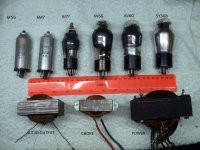Hi. I bought an "unknown amplifier". It has Mic and P.U. as sources. Clearly a mono amplifier, somewhat akin to a public address amplifier. Might have been used by a DJ in the past.
I attach a picture of the principle components. The only thing I can think of to do with these components is to make guitar amplifier. Or a regular "hi-fi" amplifier where left & right audio channels would be mixed together in the mono output. The output I think would be quite low, Maybe 10 Watts? The two 6V6G tubes are wired in push-pull, or class B. It appears it's made in France. There were two outputs, (wired in parallel,) marked H P.
I'm not entirely certain the valve marked "6J7" in the photo is the correct marking for the valve. It's not a triode valve, probably a pentode.
I need to fix that audio output transformer, but will create a new thread for that. Please comment if you have anything to say. Thank you.
I attach a picture of the principle components. The only thing I can think of to do with these components is to make guitar amplifier. Or a regular "hi-fi" amplifier where left & right audio channels would be mixed together in the mono output. The output I think would be quite low, Maybe 10 Watts? The two 6V6G tubes are wired in push-pull, or class B. It appears it's made in France. There were two outputs, (wired in parallel,) marked H P.
I'm not entirely certain the valve marked "6J7" in the photo is the correct marking for the valve. It's not a triode valve, probably a pentode.
I need to fix that audio output transformer, but will create a new thread for that. Please comment if you have anything to say. Thank you.
Attachments
Have a look at the 6V6 guitar circuits. There are some famous Fender-style amps, such as the Champ, Princeton, and Deluxe. You, may want to use more robust Soviet 6V6 equivalents. Looking at the transformers, though, they look a little wimpy for one of these guitar amps. Do some research and see how the transformer sizes correspond.
Otherwise this would make a nice preamp with the 6V6 in triode, and you could also roll a 6G6G. I just made one and it's a very worthwhile project. You have the power supply, you just wouldn't need the OPT. I used a resistor load and Russian 0.1uF FT-2 or FT-3 coupling caps. I parallel them up if I want higher values. DC Link Kemet cathode bypasses.
Otherwise this would make a nice preamp with the 6V6 in triode, and you could also roll a 6G6G. I just made one and it's a very worthwhile project. You have the power supply, you just wouldn't need the OPT. I used a resistor load and Russian 0.1uF FT-2 or FT-3 coupling caps. I parallel them up if I want higher values. DC Link Kemet cathode bypasses.
The US 6J7 is a pentode from the metal cased vacuum tube days. It was later made in the glass envelope you have, the 6J7G, and finally lade in a typical octal glass envelope as the 6J7GT. The 6F5 is a high Mu triode similar to the 6FS5.I'm not entirely certain the valve marked "6J7" in the photo is the correct marking for the valve. It's not a triode valve, probably a pentode.
It depends on the output transformer, it may not be any good for hifi use, if the original amp was a PA type then it's frequency response will be limited, it does look a bit small. Also it's secondary may be 100v line, you need to run some tests on it.
Andy.
Andy.
H. P. is an abbreviation of the French Haute Parleur, i. e. loudspeaker. So you were quite right on that.
Without a ruler ore something other to compare the size of the »iron« with, we don't have any clue about that. Anyway, if the output transformer really is a bit whimpy, it might be quite right in a geetaar amplifier to acquire »the« sound. Why do you need to fix it?
Best regards!
Without a ruler ore something other to compare the size of the »iron« with, we don't have any clue about that. Anyway, if the output transformer really is a bit whimpy, it might be quite right in a geetaar amplifier to acquire »the« sound. Why do you need to fix it?
Best regards!
The overall size of the output transformer is 63mm high, 75mm wide & 25mm depth. The core volume (over which are windings) is: 2.5Cm x 2.5Cm x 3.6Cm = 22. 5 cubic centimeters. The wires to the speaker(s) is quite thick. About 1mm dia.
Last edited:
Almost impossible. This would mean a huge transformer. Core area calculates to the middle tongue's width times stack height, so supposedly is 6.25 cm², which isn't too tight for a 10 watts output tranny, unless you need it to do 16 Hz.
Best rfegards!
Best rfegards!
I corrected a mistake in my above post. I've calculated the core volume, not the area. I'm not entirely sure what you would take as the core volume, I presumed it's the iron over which the windings are wound only. And the height of the windings is 3.6Cm.
The main parameter is core area , meaning center E leg width times stack thickness, affecting power handling and indirectly bass extension (larger core allows for more inductance if needed).
Center leg height times it's width is window area, affecting how much copper you can fit there.
By napkin calculation that transformer can be good for up to 20-25W RMS
Center leg height times it's width is window area, affecting how much copper you can fit there.
By napkin calculation that transformer can be good for up to 20-25W RMS
- Home
- Amplifiers
- Tubes / Valves
- What can I make from these components?
